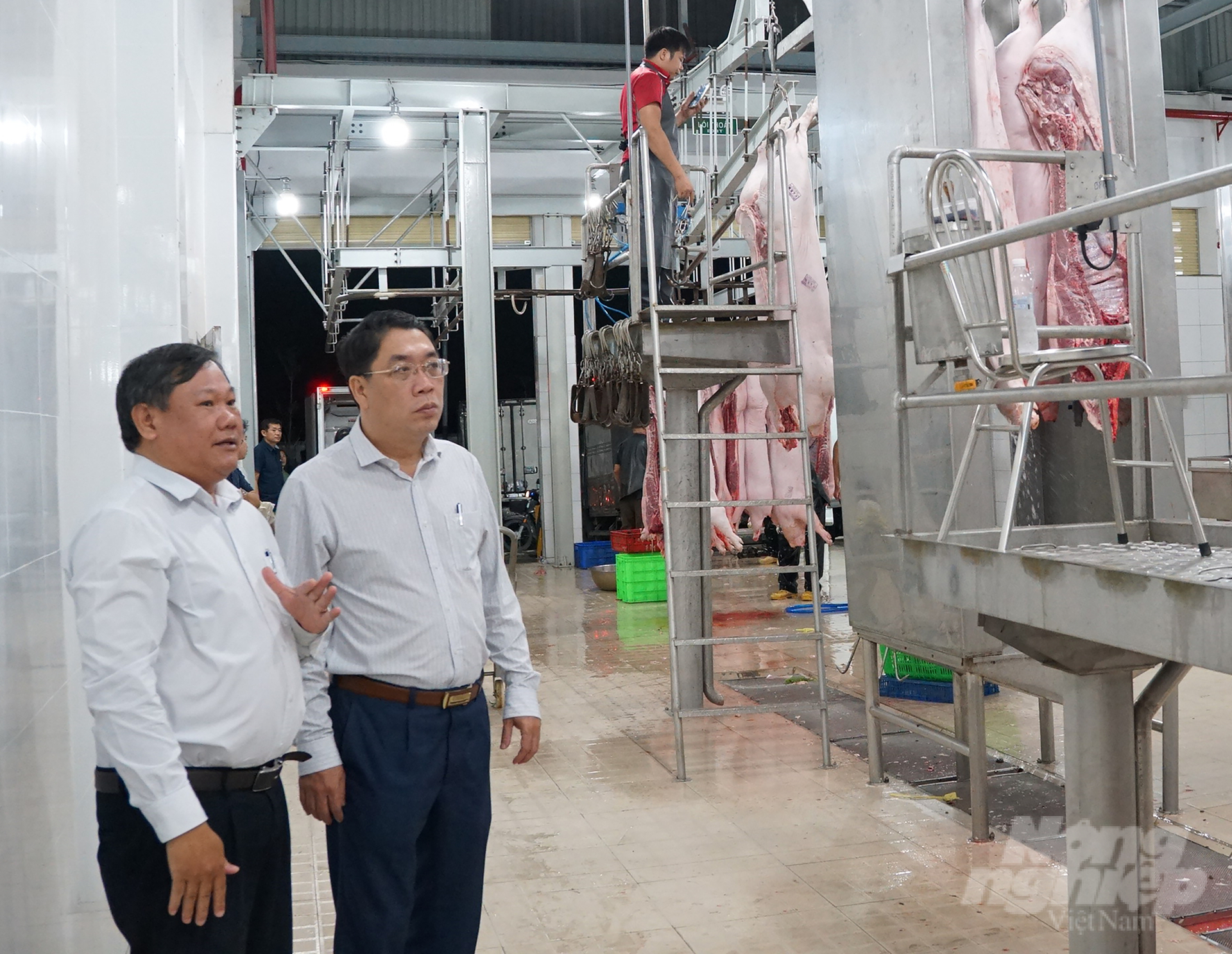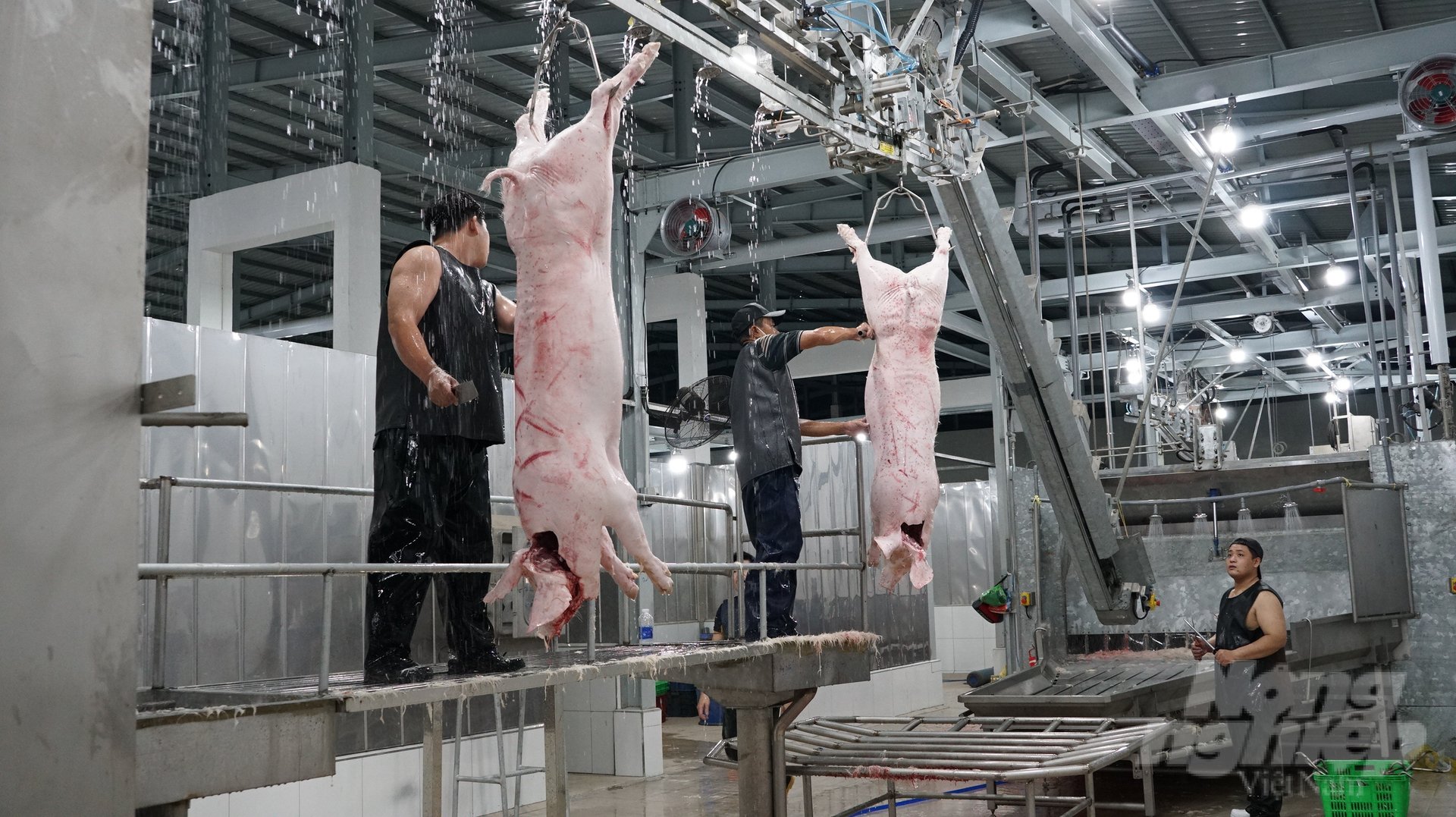June 19, 2025 | 04:19 GMT +7
June 19, 2025 | 04:19 GMT +7
Hotline: 0913.378.918
June 19, 2025 | 04:19 GMT +7
Hotline: 0913.378.918

Mr. Dinh Minh Hiep, Director of Ho Chi Minh City Department of Agriculture and Rural Development, answering inquiries at the press conference. Photo: Nguyen Thuy.
A press conference on socio-economic issues and disease prevention city was in Ho Chi Minh city held on June 8. Mr. Dinh Minh Hiep, Director of Ho Chi Minh city's Department of Agriculture and Rural Development, commented on the control of livestock and poultry slaughtering in Ho Chi Minh city at the press conference. Accordingly, Ho Chi Minh City People's Committee issued a Decision to cease the operation of all manual slaughterhouses by the end of March 31. Subsequently, all slaughtering operations were moved to industrial slaughterhouses starting from April 1.
As a result, eight manual slaughterhouses in the city have ceased operation since April 4, including Binh Tan slaughterhouse in Binh Tan district; Phuoc Kien slaughterhouse in Nha Be district; Tan Phu Trung, Hoa Phu, Phu Hoa Dong, Tan Thanh Dong, Xuyen A slaughterhouses in Cu Chi district and a manual slaughtehouse belonging to Hoc Mon Food Processing Joint Stock Company in Hoc Mon district.
According to Decision No. 231/QD-UBND, Trung Tuyen slaughterhouse in Can Gio district will remain in operation with a daily capacity of 20 to 30 pigs to supply consumers in Can Gio district.
According to Mr. Hiep, Ho Chi Minh City currrently has five industrial slaughterhouses in Cu Chi, Hoc Mon and Binh Thanh districts and one in Can Gio district. The average daily slaughter capacity from April 1 to June 8 falls between 5,200 and 6,000 heads, which can supply 60% of the market's demand for pork.
Loc An Slaughterhouse belonging to Loc An Food Company Limited is one of three industrial slaughterhouses in Cu Chi district. It has an average slaughter capacity of 900 to 1,000 pigs per day, which is an increase of at least 20% compared to its slaughter capacity before April 1. The slaughterhouse has a designed capacity of 2,000 pigs per day.
A slaughterhouse belonging to Saigon Agriculture Incorporation Company (Sagri) currently has an average slaughter capacity of 50 to 80 pigs per day; which is an increase of 45% compared to its slaughter capacity before April 1. This slaughterhouse also has a designed capacity of 2,000 pigs per day.
An Ha cattle slaughtering and food processing plant belonging to An Ha Service Co., Ltd currently has an average slaughter capacity of 1,900 to 2,300 pigs per day; which is an increase of 8% compared to its slaughter capacity before April 1. This processing plant has a designed capacity 3,200 heads per day.
Xuan Thoi Thuong slaughterhouse belonging to Hoc Mon Food Processing Joint Stock Company in Hoc Mon district currently has an average slaughter capacity of 1,900 to 2,100 pigs per day; which is a decrease of 6% compared its capacity before April 1. The slaughterhouse has a designed capacity of 2,000 pigs per day per plant.
A slaughterhouse in Binh Thanh district belonging to the Vissan Joint Stock Company currently has an average slaughter capacity of 400 to 500 pigs per day. This slaughter house has a designed capacity of 1,000 pigs per day.

Ho Chi Minh City Department of Agriculture and Rural Development inspecting An Ha cattle slaughtering and food processing plant. Photo: Nguyen Thuy.
According to Mr. Dinh Minh Hiem, there was negligible changes in the overall supply of pork to the city market compared to before April 4, with an average output of approximately 9,500 to 10,000 pigs per day.
The daily source of slaughtered pigs in the city decreased by nearly 700 to 1,200 heads, which is a decrease of 10 to 15%. This decline was caused by cattle owners moving to Long An, Binh Duong for slaughter, then delivering them back to Ho Chi Minh City. On the other hand, some cattle owners switched to selling meat instead of buying live pigs for slaughter.
Moreover, the amount of pork brought from the provinces to the city for consumption during this period increased by roughly 500 to 1,300 pigs, which is an increase of 15 to 20%.

An Ha cattle slaughtering and food processing factory was designed with a daily slaughter capacity of 3,200 pigs. Photo: Nguyen Thuy.
The Ministry of Agriculture and Rural Development held a "Conference on control of animal slaughter, and implementing Directive No. 02/CT-TTg by the Prime Minister" on June 3 in Hanoi city. According to Ms. Nguyen Thu Thuy, Deputy Director of the Department of Animal Health, local governments are effectively organizing concentrated and industrial-scale animal slaughter activities, controlling food safety, and traceability when necessary. Namely, the governments of Ho Chi Minh City, Ha Tinh, Long An, Thua Thien Hue, Ba Ria - Vung Tau provinces were praised for their success.
"Ho Chi Minh City has worked on converting from manual slaughterhouses to industrial slaughterhouses for the past ten years. This is the only city in Vietnam that has completed its conversion to industrial slaughterhouses" Mr. Dinh Minh Hiep reported.
The control of slaughter at industrial slaughterhouses in Ho Chi Minh City have reportedly ensured the requirements for animal health and hygiene.
"The volume of slaughter at industrial slaughterhouses have been relatively stable. However, these industrial slaughterhouses have not reached their designed capacity. If we connect with more partners for industrial cattle slaughter, these slaughterhouses will increase their capacity and maintain the supply of pork to meet the needs of consumers", added Mr. Hiep.
The Sub-Department of Livestock Production and Animal Health of Ho Chi Minh City recently strengthened the inspection of manual slaughter in the city, with a focus on District 12, Go Vap, Binh Chanh, but no such cases were found.
Translated by Nguyen Hai Long
![Turning wind and rain into action: [9] Digitizing hydrometeorological data in response to climate change](https://t.ex-cdn.com/nongnghiepmoitruong.vn/608w/files/news/2025/06/17/z6704423696987_15fd32ffc26d590d204d520c9dac6786-nongnghiep-165943.jpg)
(VAN) Farmers have begun accessing hydrometeorological applications to adjust their cropping schedules, aiming to ensure productivity and adapt to climate change.
![Turning wind and rain into action: [8] Real-time salinity detection and early warning technology](https://t.ex-cdn.com/nongnghiepmoitruong.vn/608w/files/news/2025/06/17/z6704423696987_15fd32ffc26d590d204d520c9dac6786-nongnghiep-151127.jpg)
(VAN) Thanks to the integration of modern hydrological-hydraulic models, remote sensing technologies, and artificial intelligence, the accuracy of hydrological forecasting has significantly improved.
![Turning wind and rain into action: [7] Early disaster warnings help marine farmers minimize losses](https://t.ex-cdn.com/nongnghiepmoitruong.vn/608w/files/news/2025/06/17/z6704423696987_15fd32ffc26d590d204d520c9dac6786-nongnghiep-142942.jpg)
(VAN) In recent years, thanks to early disaster warnings and forecasting, marine farmers in Khanh Hoa province have been able to reduce risks and losses, thereby improving production efficiency.
![Turning wind and rain into action: [6] ‘Four on-the-spot’ disaster management software](https://t.ex-cdn.com/nongnghiepmoitruong.vn/608w/files/news/2025/06/17/e5a48259d6a262fc3bb3-nongnghiep-183800.jpg)
(VAN) By simply activating the scenario on the disaster management software, the relevant authorities immediately know how many households need to be evacuated, where to evacuate them to, and by what means of transportation…
![Turning wind and rain into action: [5] Hue applies modern technology in disaster forecasting](https://t.ex-cdn.com/nongnghiepmoitruong.vn/608w/files/news/2025/06/17/z6704423696987_15fd32ffc26d590d204d520c9dac6786-nongnghiep-093938.jpg)
(VAN) In Hue city, modern technology has recently been applied in meteorological and hydrological forecasting and warning, helping to reduce the damage caused by natural disasters.

(VAN) A cutting-edge farming technique being implemented on an experimental ranch in Arizona's Sonoran Desert has already saved a billion gallons of water over five years, according to Civil Eats.

(VAN) Poultry and pig production and the environment can be boosted through enhanced water technology, according to new research.